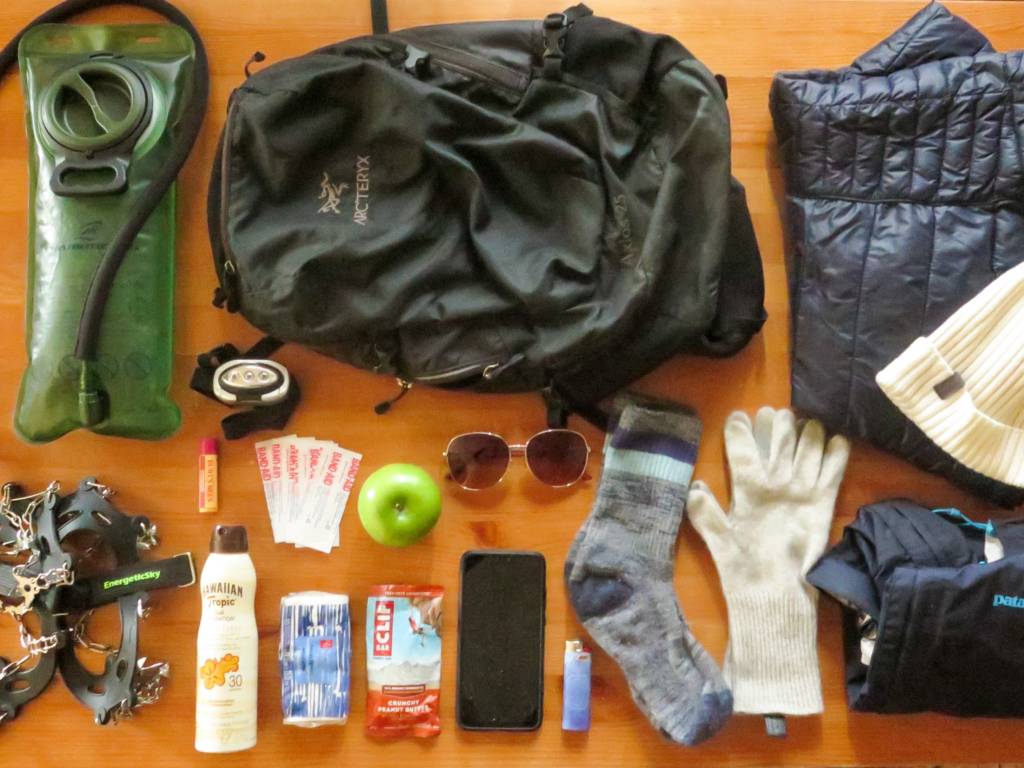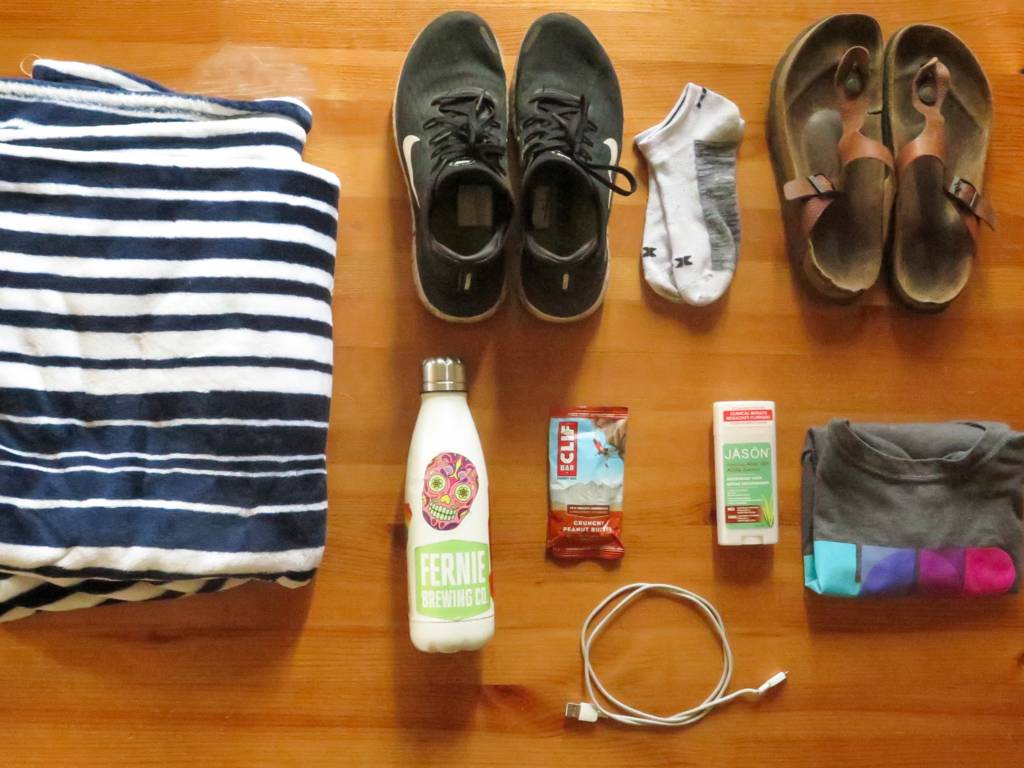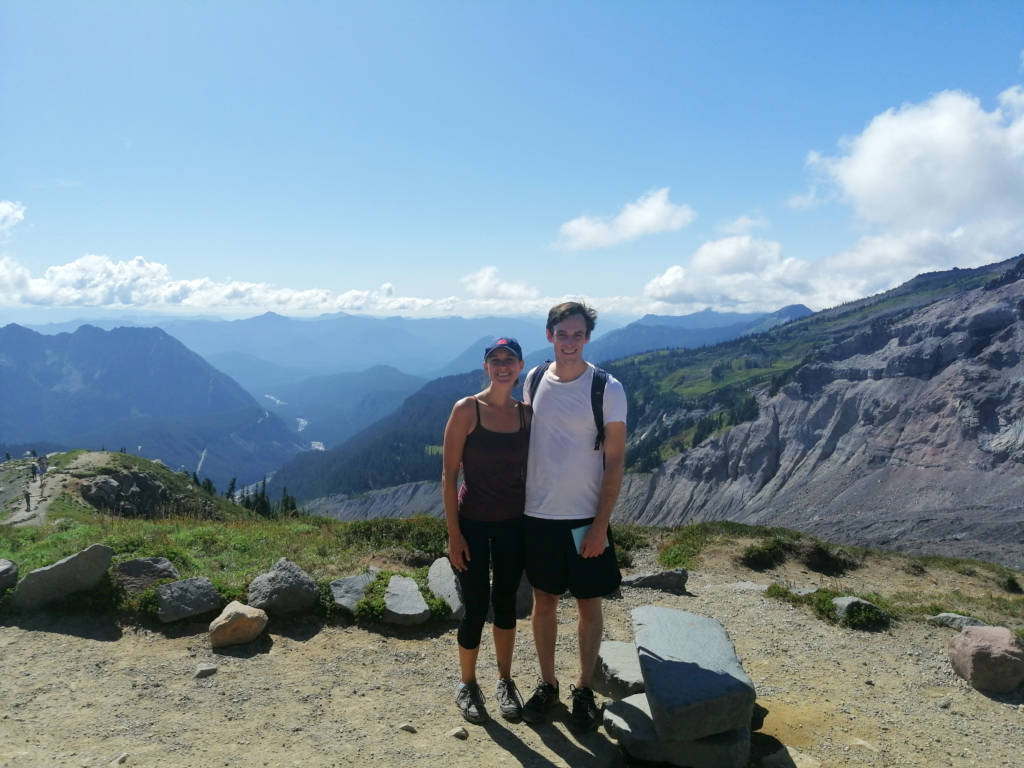Below you will find my daypack essentials for winter hiking. This is a guide for sea-level trails that are snowless or for maintained snowshoe trails in fair weather. If you are going deep into the backcountry, into an area with avalanche danger, or somewhere with sudden weather changes or far below freezing temperatures do more research and consult an expert on what gear you should bring and what safety precautions you should know.
If you are looking for my summer pack list find it here.
Here in British Columbia, Canada we get cold winters but still milder than the central provinces. Winter weather patterns can change suddenly and it can become easier to get lost and your body will shut down a lot faster than in the summer, that’s why it important for me to go prepared with this bare-minimum packing list below, and much more if I know I will be going into extreme conditions. I have seen far too many stories about people getting lost in a snowstorm only wearing shorts and a t-shirt, please don’t be that person.
I love winter hiking because normally it means fewer people on the trails, and a bit of snow makes everything magical. Just pack some extra layers and the rest of the items on the list below. Do your research to find out if you need more!
What’s in My Pack

1. Water – this is, of course, a basic necessity on any hike. I have a 2-liter water bladder I always bring with me as well as an extra water bottle if the hike is long. I have such a hard time remembering to drink water in the cold weather, but your body needs it just as much as in the summertime so make sure to remind yourself to hydrate!
2. Sunglasses– have you ever had the sunlight reflect off the snow and make you feel temporarily blind? Yeah, it’s not pleasant. Sunglasses make hiking in the snow so much better. If you are going somewhere without snow on an overcast day you are probably good to leave them at home.
3. Layers – so important on a winter hike. I will usually wear thick leggings, wool socks, a thermal top, my puffer jacket, and a warm hat. I usually bring an extra waterproof layer for my legs, extra socks, gloves, an extra sweater or two, a waterproof jacket, and some kind of face-covering like a scarf or balaclava. It’s a lot to store in your pack but if you get caught in a snowstorm or cold snap this could save your life. Also, a waterproof layer is great to sit on if you need to take a break in the snow.
4. Sunscreen – even when it’s cold outside sunscreen is a must. Just like the sunglasses, the light reflecting off the snow can give you a worse sunburn than the overhead summer sun. The good news is, usually only your face will be exposed to the elements so you don’t have to bring much product.
5. Band-Aids and/or Blister Pads – I have these in my pack all year round, I usually get blisters at the beginning of the winter after I have traded in my thin socks for thick wool ones. It takes a minute for my feet to get used to the new socks. After you have the band-aids in your pack the only obstacle you have to conquer is taking off your shoes and socks in the snow, burr. It might be smart to preemptively band-aid the parts of your feet that you know are blister-prone so that you don’t have to risk sticking your toes in the snow.
6. Food – always bring a snack, even on a short hike. A 1-hour walk in the summer could be doubled in the snow so it’s good to have even a small item to put in your stomach and keep your energy levels up. Again, you never know what could happen, so at least toss a granola bar in your pack. I have created a list of my favorite day hiking lunches that you can peruse here.
7. Headlamp or Flashlight – I have a headlamp in my pack on every hike all year long, it’s a very important safety item for me. The sun can set very early in the winter and you do not want to be lost in the woods and the snow in the dark. Just throw it in your pack, it doesn’t weigh much.
8. Chapstick – I have chapstick with me wherever I go. Usually, this is a bit of a luxury item but in the cold thin winter air your lips get chapped so fast (especially if you forget to drink water in cold weather as I do) and it’s such a relief to have some lip balm to soothe them.
9. Cellphone – this might seem funny to put on the list as usually everyone carries their phone with them everywhere, but I want to draw attention to this incredible multi-tool. Firstly, this can be a map, compass, camera, and flashlight but it also tracks you. Even in airplane mode, your phone can be tracked by GPS. If you are lost this could be a life-saving device, allowing search and rescue to locate you.
10. A Map – it is incredibly important to have a map if you are going for a hike in the snow. If there is fresh snow the trail could be completely covered and you could get lost very easily. Even if you head up the trail and it’s tracked out and easy to follow, there could be fresh snow on the way back, making it easy to get lost. . It is not okay to take the risk on a snow-covered hike. A downloaded map on your phone will likely do the trick, but consider something physical if you are going somewhere less traveled.
11. Tissues – if you are like me your nose starts running as soon as you start exercising in cold weather and it is miserable. You can thank me later for this one.
12. A Lighter, Matches, or Flint –an item that takes up little space and weighs close to nothing but could save your life. Just put it in your pack and forget about it.
13. A Friend or Family Member Who Knows Where You Are – Okay so this doesn’t technically go in your pack, but if I had to give one safety tip to anyone who was setting out for a wilderness excursion this would be it. Search and rescue can find you from your cellphone ping but if they don’t know that you are missing it might be too long for them to even start looking.
Send a quick text to a loved one in your life that says where you are going and what your latest expected return time is, then text them when you return. If you are not back by that time they will know to alert someone that you are missing and may need help.
Other options include posting on an online hiking group or leaving a note on the dash of your car; however, neither is ideal.
14. A Permit – a lot of trails get taken over by ski resorts in the winter. A trail that might have been free to all in the summer might suddenly be in a fee zone when the snow starts to fall. Check before you go to see if you need a pass or liability waiver. There are still plenty of snowshoe trails that are free to all, check out my guide to free snowshoe trails near Vancouver here.
15. Crampons/Snowshoes – if you are going on a coastal hike, there’s a chance you won’t need to wear anything on your feet but hiking boots. If you are going on a hike that is icy and tracked out, so the snow is quite compact and hard you might just need crampons, if there has been significant recent snowfall, snowshoes are a must. Assess the recent weather patterns, and research what the trail conditions are before you set out.
16. An Emergency Blanket – This is a small lightweight item that could save your life if something goes wrong while hiking. You can find emergency blankets at outdoor stores and they usually cost $5-$10 and are well worth it. Keep this in your bag all winter (and summer too) to keep you warm if you get stuck in the backcountry overnight, or in a situation where you can’t get warm enough.
Bonus: Avalanche Gear. Take a minute to consider if you will be traveling in an avalanche-prone area. If you are going somewhere that has maintained trails you should be fine without. If you are going into an unmaintained backcountry area, definitely do your research before you go and bring all the necessary life-saving gear you may need. If you do not have the gear, some websites tell you the avalanche danger or different places on different days. Check-in on one of these websites and choose a different time to do your hike if the danger is high.
What’s in My Car

I always keep a little basket of comfort items in the car for when I return from a hike. These are not life-saving items or necessities, they are mostly just comfort items. Getting back from a hike cold, sweaty, hungry, or thirsty and then having to endure the drive home can be uncomfortable so I try to bring some things that will bring me instant comfort and joy.
Be sure not to leave any valuables in your car. It’s sad, but thieves do target hiking trailheads since they know hikers will be gone all day. If they don’t see anything blatantly valuable through the windows they might not try at all. If they do break into cars, at least if they don’t find anything it will deter them from coming back.
1. A Spare Pair of Socks/Shoes– your feet might be cold and wet or blistered and a fresh pair of socks and some comfy shoes will feel really good. Your feet will thank you.
2. A Full Water Bottle and/or Electrolyte Drink – if you drank all of your water on the trail it will be so nice to find a drink in your car when you get back. If you are hiking in freezing temperatures be sure to consider that the drink might be frozen when you get back, this could be remedied by using a temperature-controlled container.
3. Deodorant and a Spare Shirt – It feels so good to take off that stinky smelly shirt immediately and feel like a regular less-smelly person.
4. A Snack – if you ate all of your food on the trail and you are starving afterward it’s good to have some snacks in the car, especially if you are far away from amenities. Like the water, consider what you pack so it’s not frozen when you return.
5. A Car Phone Charger – if you are like me you are using your phone for a lot on the trail, such as using it as a GPS/map and taking lots of pictures. Sometimes this can wear your phone out and if you need it for directions to get home it’s nice to know you can access those directions by turning on your car and plugging in.
6. A Blanket – I have been told to keep a blanket or two in the back of my car since I turned 16 and got my driver’s license. If something goes wrong and you are stuck out on a backroad, blankets could come in hand. Pus they can just be nice and cozy after a long cold hike.
7. Tire Chains – this is a situational one, if you have 4WD and good winter tires you are probably okay, but I have had instances where to access the trailhead it was required that you put chains on your tires no matter what kind of vehicle you have, just do your research first and be prepared. We keep ours in the trunk of our car all winter long for safety.
I am most more conscious about making sure I have everything thing I need in my winter daypack than I do with my summer daypack. In the summer, here in British Columbia, I feel like I have a bit more control over what might happen to me, even with the bears out in full force I know how to deal with them in a normal situation. In the winter the conditions can be a lot more extreme and can change a lot faster. Temperatures can drop rapidly as you ascend a mountain and there’s a chance of avalanches or getting trapped under falling tree snow. There can be a sudden whiteout storm that can lead you off course and lost. I don’t mean to scare you because winter hiking is beautiful, but always be prepared and do your research before you go.
Overall, enjoy your winter hike and I hope I have brought some new packing ideas into your life!

Welcome to Alpine Feeling! My name is Talon, and I am a Vancouver local who loves hiking and all things outdoors. I am here to do my best to provide you with outdoor guides to the Vancouver area and beyond.


